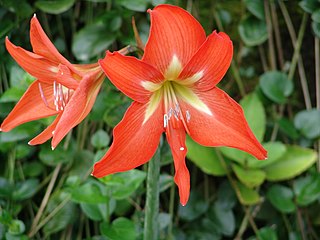
Hippeastrum is a genus of about 90 species and over 600 hybrids and cultivars of perennial herbaceous bulbous plants. They generally have large fleshy bulbs and tall broad leaves, generally evergreen, and large red or purple flowers.
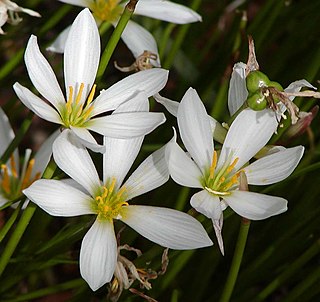
Zephyranthes is a genus of temperate and tropical plants in the Amaryllis family, subfamily Amaryllidoideae, native to the Western Hemisphere and widely cultivated as ornamentals. Following the expansion of the genus in 2019, which now includes the genera Habranthus and Sprekelia, there are about 200 recognized species, as well as numerous hybrids and cultivars. Common names for species in this genus include fairy lily, rainflower, zephyr lily, magic lily, Atamasco lily, and rain lily.

Sprekelia is a genus of Mesoamerican plants in the Amaryllis family, subfamily Amaryllidoideae. Sprekelia plants are sometimes called Aztec lilies or Jacobean lilies although they are not true lilies. This genus has been submerged in Zephyranthes, but as of January 2023 is accepted by Plants of the World Online with a single species, Sprekelia formosissima, endemic to Mexico.

Zephyranthes robusta, synonym Habranthus robustus, commonly known as the Brazilian copperlily, pink fairy lily or the pink rain lily, is a species of herbaceous flowering bulb. It is native to Brazil, Argentina and Uruguay, but is now naturalized in Florida, Colombia, South Africa, and Mauritius.

Eucrosia is a genus of herbaceous, perennial and bulbous plants in the Amaryllis family distributed from Ecuador to Peru. The name is derived from the Greek eu, beautiful, and krossos, a fringe, referring to the long stamens. The genus contains eight species. Phaedranassa and Rauhia are the genera most closely related to Eucrosia.
Habranthus (copperlily) was a formerly recognized genus of tender herbaceous flowering bulbs in the subfamily Amaryllidoideae of the family Amaryllidaceae. It is now included within a more broadly circumscribed genus Zephyranthes. The genus was first identified by pioneering bulb enthusiast William Herbert in 1824.

Caliphruria is a genus of herbaceous, perennial and bulbous plants in the Amaryllis family The four species grow in tropical areas of South America, with three endemic to Colombia, but are rare in the wild. This genus is closely related with the genera Eucharis and Urceolina, all of them known colloquially as "Amazon Lilies".
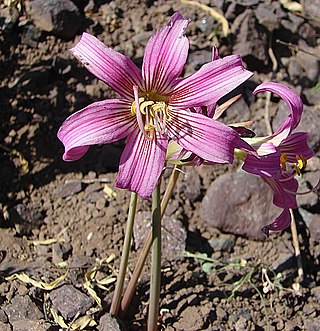
Rhodolirium is a small South American genus in the tribe Hippeastreae of the family Amaryllidaceae. Although originally described by Philippi in 1858 it has long remained buried in other taxa, principally Hippeastrum and more recently Rhodophiala. Only in recent years has it been rehabilitated.

Zephyranthes rosea, commonly known as the Cuban zephyrlily, rosy rain lily, rose fairy lily, rose zephyr lily or the pink rain lily, is a species of rain lily native to Peru and Colombia. They are widely cultivated as ornamentals and have become naturalized in tropical regions worldwide. Like all rain lilies, they are known for blooming only after heavy rains.
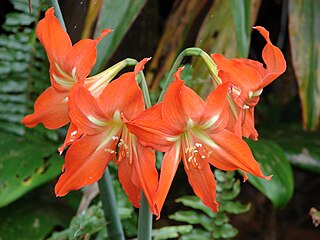
Hippeastreae is a tribe of plants belonging to the subfamily Amaryllidoideae of the Amaryllis family (Amaryllidaceae). Species in this tribe are distributed in South America. Flowers are large and showy, zygomorphic, with the stamens in varying lengths, inflorescence bracts are often fused basally. The seeds are flattened, winged or D-shaped. Reported basic chromosome numbers are x= 8-13, 17, and higher. All the species in this tribe present a remarkable aesthetic interest and horticultural value.
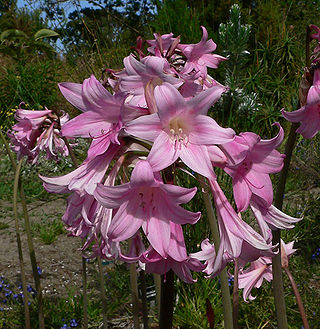
Amaryllidoideae is a subfamily of monocot flowering plants in the family Amaryllidaceae, order Asparagales. The most recent APG classification, APG III, takes a broad view of the Amaryllidaceae, which then has three subfamilies, one of which is Amaryllidoideae, and the others are Allioideae and Agapanthoideae. The subfamily consists of about seventy genera, with over eight hundred species, and a worldwide distribution.

Hippeastrinae is a subtribe of plants classified under the tribe Hippeastreae. It belongs to the subfamily Amaryllidoideae of the Amaryllis family (Amaryllidaceae).

Phycella is a genus of herbaceous, perennial bulbous flowering plants belonging to the family Amaryllidaceae, subfamily Amaryllidoideae. The genus consists of five species distributed from central Chile to northwestern Argentina.
ZephyrantheaeSalisb. is a now obsolete tribe within the American clade of family Amaryllidaceae, containing five genera.

Traubiinae is a subtribe of plants classified under the tribe Hippeastreae. It belongs to the subfamily Amaryllidoideae of the Amaryllis family (Amaryllidaceae).

Hippeastrum mirum is a species of herbaceous perennial bulbous flowering plants in the amaryllis family, Amaryllidaceae, subfamily Amaryllidoideae. It was formerly treated as Tocantinia mira, the only species in the monotypic genus Tocantinia.

Famatina was a small genus of South American bulbous plants identified by the Chilean botanist Ravenna in 1972. Five species have been described. Molecular phylogenetic studies suggested the genus was polyphyletic, and species have been moved to other genera.















